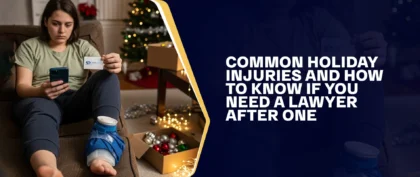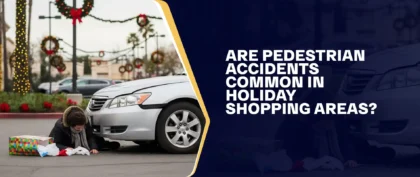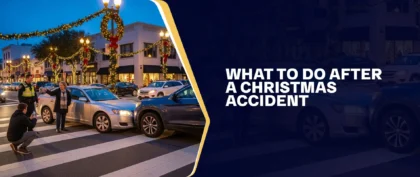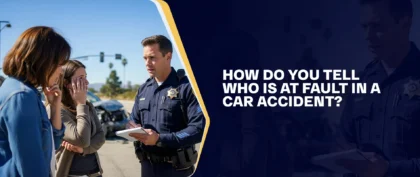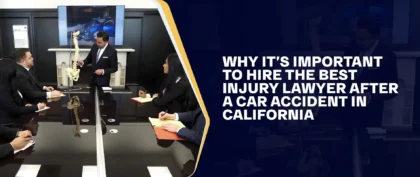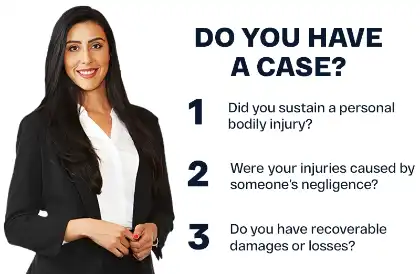Table of Contents
Driving is a rite of passage for many teenagers. Although people believe that driving lessons end after acquiring a driver’s license, this is not typically the case. Advancing your driving skills is a lifelong process.
Driving is more than just listening to your parents and other adults; it is also about educating yourself on safe driving habits that can save your life and the lives of others in the event of a car accident. In addition to adhering to the basic driving rules, such as wearing a seatbelt, driving within the speed limit, maintaining focus, and driving sober, also follow other safety measures.
For instance, if you find yourself injured in a traffic crash caused by another person, you have to understand how car accident lawyers can help. These attorneys can advocate for your rights, guide you through the legal system, and support you in seeking compensation.
Remember, operating a vehicle is a privilege, not a right. With road accidents waiting to happen, one must be well-equipped to face challenges and maintain the proper driving practices before getting behind the wheel.
Teen Driving Guide: Step-By-Step Driving Lessons For Young And New Drivers
Learning to drive a car is not as hard as it sounds. Experienced drivers often compare driving a car to riding a bike. However, driving requires practice, so honing one’s driving skills is needed for a safe and enjoyable driving experience. Of course, every driver has to start at the beginning.
Common Traffic Signs And Meanings
To begin your driving journey, you have to familiarize yourself with the traffic signs to practice safe and responsible driving. According to Road Traffic Signs, different shapes correspond to different meanings:
| Shape | Indication | Common Signs |
| Octagon | Stop | Stop Sign |
| Diamonds, Triangles | Warning, Hazard | Yield Sign, Voltage Sign, Warning Sign |
| Oval, Circles | Welcome | Welcome Sign, Community Sign |
| Squares, Rectangles | Miscellaneous | Parking Signs, Direction Signs, Notice Signs |
Here are the common types of traffic signs and their meanings:
- Turn Left Ahead — Indicates that you are preparing to make a left turn.
- No Left Turn — Prohibits left turns at an intersection or location.
- No Motor Vehicles — Indicates that motor vehicles are not allowed on the road.
- Bend to the Left — Warns of a road ahead that curves to the left.
- No Overtaking — Prohibits passing other vehicles on a stretch of road.
- Two-Way Traffic — Informs drivers that they are on a road with traffic in both directions.
- Road Work — Warns of construction or road maintenance ahead.
- Turn Right Ahead — Indicates that you are preparing to make a right turn.
- Hump — Alerts drivers to the presence of a speed bump or raised road surface.
- Roundabout — Informs drivers of a roundabout intersection ahead.
- No Right Turn — Prohibits right turns at an intersection or location.
- Crossroads Ahead — Warns of an upcoming intersection or crossroads.
- Give Way — Indicates that you are yielding the right-of-way to other vehicles.
- Maximum Speed — Displays the allowable speed limit on the road.
- No Cycling — Prohibits bicycles on the road.
- One-Way Traffic — Traffic should only flow in one direction on the road.
- Falling Rocks — Warns of the danger of rocks or debris falling onto the road.
- Wild Animals — Caution drivers about the potential presence of wildlife on the road.
- Merge — Informs drivers that two lanes of traffic are merging into one.
- Parking Lot — Indicates the location of a parking area or lot.
- Stop & Give Way — Requires drivers to come to a complete stop and yield the right-of-way to other traffic.
- No Parking — Prohibits parking in the designated area.
- Bend to the Right — Warns of a road ahead that curves to the right.
- Slippery Road — Caution drivers about the road being slippery, often due to wet or icy conditions.
- Uneven Road — Warns of a road surface that is uneven or rough.
After you learn the important traffic signs and regulations, you have to be aware of the current speed limits in your area. For example, California’s multi-lane freeways have a speed limit of 65 mph, but some regions have a 70 mph limit. On the other hand, highways with two lanes generally have a 55 mph speed limit. City streets usually have speed limits of 35 mph, while residential areas and schools usually have a speed limit of 25 mph.
After familiarizing yourself with the basics, here are the steps to take before and during your first drive:
Step 1 – Get To Know Your Vehicle
Before even starting the engine, familiarize yourself with the car’s manual first. This step will give you insights into the specific features and controls unique to that vehicle. Familiarize yourself with the locations and functions of critical controls such as headlights, wipers, indicators, hand brakes, and hazard lights. Remember to keep the insurance card, manual, and car registration in a safe yet accessible place inside your vehicle at all times. If you have a driver’s permit, bring it as well.
Step 2 – Setting Up Your Car
Before setting off, take a moment to inspect the vehicle for any visible damage or issues. Check your tires to see if they are adequately inflated. If they are not, inflate them until they reach the right tire pressure.
Hint: You can find the tire pressure information and other important facts about your car on the jamb sticker on the driver’s door.
Step 3 – Adjust For Safety
It is important to make safety a priority. Accidents can be significantly reduced by properly adjusting your seat and car accessories, such as mirrors and seat belts.
Get Into Your Proper Driving Posture
When you get in a vehicle, the first thing to do is to adjust your seat for optimal comfort and control reach. Your seat should be adjusted to a height that allows you to see the road clearly without obstructing your view. Your line of sight should be at least a few inches above the steering wheel. Move the seat forward or backward until you can fully depress the brake pedal while keeping a slight bend in your knee. Your feet should comfortably reach the pedals without overextending your legs.
Set Your Steering Wheel
Afterward, adjust your telescopic steering wheel so you can comfortably reach the wheel with your hands in the positions mentioned above and maintain a relaxed posture. If your car has a tilt adjustment, release the lever and move the steering wheel up or down to a comfortable position. The ideal position is where your hands rest on the steering wheel at the 9 and 3 o’clock positions with a slight bend in your elbows. Here’s an example of steering wheel hand positions:
Adjust Your Mirrors
Next, set the rearview and side mirrors to provide optimal visibility. Here’s a video that shows you how your mirrors should be positioned.
Fasten Your Seatbelts
Begin every drive by fastening your seatbelt and checking that passengers do the same. Additionally, all drivers should be prepared for emergencies, so keep an emergency kit in your car.
Step 4 – Start The Engine
Before turning on the engine, check that the car is in “park” mode for automatic transmissions or “neutral” for those using manual transmissions and that the hand brake is engaged. Once you turn the key or press the ignition button, check the dashboard lights for any warnings.
Step 5 – Basic Controls
Before moving, it’s a good practice to familiarize yourself with the accelerator and brake pedals. Understanding gear shifts and practicing using the clutch are essential for those learning to drive a car with a manual transmission.
Steering is another necessary control feature that allows drivers to maneuver the roads. Proper steering involves looking in the direction you want to go and using both hands for control. It’s advisable to first practice turns at slow speeds, ideally in an empty parking lot.
Step 6 – Moving Off And Stopping
When you’re ready to start driving, check the mirrors and blind spots first. Use the appropriate signal to indicate your intentions, even when driving out of the parking lot. As you set off, remember to release the hand brake, and for manual cars, synchronize the clutch release with the accelerator press. Whenever you have to stop, press the brake pedal gently and place the car in “park” mode or “neutral” for manuals.
It may take several test drives to figure out how to get from point A to point B, how much pressure to apply to the brakes for stopping, or how far to turn the steering wheel.
Step 7 – Using Signals And Indicators
Communication on the road is vital. Use signals to announce your intentions, such as entering traffic, merging, or changing lanes. Remember to turn off your signal once the intended action is complete. Not doing so can confuse and distract other drivers.
Step 8 – Basic Road Skills
Understanding and respecting traffic signs and signals is essential for safe driving. Keep a safe distance from the vehicle in front, and stay aware of your surroundings by frequently and quickly checking mirrors.
Driving on highways, merging, and understanding defensive driving principles are all essential components of good driving skills. As you continue practicing, you’ll slowly but surely expose yourself to various driving conditions, such as nighttime or inclement weather. You have to be able to make quick decisions to keep yourself and your passengers safe. As a novice driver, you’ll need to focus more on developing your safe driving skills before moving on to the rest.
Step 9 – Parking
Parking is a skill developed with practice. Start in an empty parking lot and learn about various types, from parallel to perpendicular and angle parking. As you progress in your driving journey, take time to review and assess your skills. Accept feedback from professional instructors or experienced drivers, and remember to prioritize safety in your driving decisions.
How To Drive A Manual Car
A manual car offers more control over the vehicle’s performance but requires more attention to gear management.
- Starting the Car — Insert the key into the ignition. Place the gear stick in the neutral position (N). Depress the clutch pedal with your left foot all the way down. Turn the key to start the engine.
- Moving Off — With the clutch still pressed, move the gear stick to the first gear. Gradually release the clutch while slowly pressing the accelerator with your right foot. As you feel the car beginning to move, you’re finding the “bite point” of the clutch. Once the car is moving, fully release the clutch.
- Changing Gears — As the car gains speed and the engine’s RPM rises, it’s time to shift to the next gear. Depress the clutch fully. Move the gear stick to the next gear. Gradually release the clutch while giving the car some throttle.
- Stopping — Remove your foot from the accelerator as you prepare to stop. Press the clutch down and shift the gear stick back to neutral. Use the brake pedal to bring the car to a stop.
- Downshifting — This is when you shift to a lower gear. As your speed decreases or when driving uphill, downshift to provide more power to the wheels. Depress the clutch and shift to a lower gear. Gradually release the clutch while giving the car some throttle.
- Parking — Once you’ve stopped, put the gear stick in first gear or reverse (this prevents the car from rolling). Then, apply the handbrake.
How To Drive An Automatic Car
Automatic cars offer a simpler driving experience, which is especially beneficial in stop-and-go traffic.
- Starting the Car — Insert the key into the ignition or press the start button (depending on the car model). Place the gear selector in the “Park” (P) position. Turn the key or press the button to start the engine.
- Moving Off — Depress the brake pedal with your right foot. Move the gear selector to “Drive” (D). Gradually release the brake pedal and press the accelerator to move forward.
- Stopping — Simply release the accelerator and press the brake pedal.
- Parking — Move the gear selector to the “Park” (P) position once you’ve stopped. If on an incline, applying the handbrake is also a good practice.
Using Other Modes
- Reverse (R) is used for backing up.
- Neutral (N) disengages the transmission and allows the car to roll freely (not generally used when driving).
- Some modern automatic cars may also have a “manual” or “sport” mode, allowing for manual selection of gears via paddles or the gear stick. They have lower gears (1, 2, L, etc.) that can be manually selected and are helpful for steep declines or when more engine braking is required.
Basic Driving Skills For Beginners And Teenagers
Every driver starts at the same point of learning. The following tips will help you develop essential driving skills before you hit the road.
Communicating with other drivers. Stopping, slowing down, and signaling are just a few skills you will need to learn.
Using hazard lights. Use your hazard lights when you become a potential hazard for other road users. The red triangle-shaped button is usually used to activate them. Many dashboards have this button in the center.
Reversing your vehicle. Turn your head and check your side mirrors to avoid backing around sharp curves or corners. When reversing your car, practice turning your vehicle left and right.
Driving a stick shift. In manual transmissions, it is important to practice shifting through all the gears and depressing the clutch when shifting.
Crossing intersections. This guide can help you learn how to navigate intersections.
- Slow down as you approach. Stay alert for signs, signals, and road markings.
- Before crossing, look left, then right, then left again to confirm that it is safe to proceed.
- Be aware of traffic signals and obey them (red means stop, green means go, yellow means slow down and prepare to stop). Stop completely at a stop sign.
- Yield to pedestrians in crosswalks and those waiting to cross.
- Keep an eye out for vehicles in your blind spots that may run a red light or stop sign.
- When making a turn, use your signal. Yield to oncoming traffic when making a left turn. Check for pedestrians and cyclists before making a right turn.
- Stay in your lane, and do not change lanes at intersections.
- Proceed with caution, even if you have the right of way.
- Keep safety in mind at all times. To avoid an accident, it’s better to wait a few seconds until the path clears.
Driving on the freeway. Freeway driving is much faster than driving in a residential area. Practice entering and exiting the freeway using long on-ramps and off-ramps. Follow the three-second rule and adjust your lane position as necessary based on traffic conditions.
Keep a safe distance around your vehicle. A good driver maintains a safe “space cushion” so they can remain aware of traffic conditions. You will have more time to notice a hazard or collision down the road if you allow more space between your vehicle and the vehicle ahead.
Selecting the right lane. Lanes should be chosen carefully. Depending on the driving maneuver you are performing, such as turning or parking, select the appropriate lane. It is recommended to pick the least congested lane, except when you are turning or stopping. The right lane should be selected if there are two lanes moving in the same direction. On the other hand, choose the middle lane if you have the choice between three lanes, while using the left lane if you want to pass or turn left. Otherwise, choose right.
Changing lanes. The ability to change lanes smoothly takes practice. Before changing lanes, check traffic, glance in your mirrors, check your blind spot, and signal.
Turning your car. Parking lots with large, open spaces are excellent for practicing how to make turns. Learn how to steer during a turn. Before you practice making left turns, master right turns first, as wide turns can be dangerous with oncoming traffic.
- Turning Right — Check traffic to the left, right, front, and rear. Before turning, slow down and let other drivers know by signaling at least 200 feet beforehand.
- Turning Left — Keep your eyes on the lane you are entering as you check traffic, slow down, and signal.This helps avoid left-turn accidents.
Making a U-turn. You can practice U-turns on a wide residential street with little to no traffic. Whenever traffic is heavy, it is not a good idea to make a U-turn. Before turning and turning, look in all directions for traffic. Keep an eye out for traffic, as it can appear within seconds.
Parking. Learning to park is a necessity for all drivers. You have to learn these skills:
- Parking on Hills — When you are parking on hills, try to do so in areas with no other parked vehicles nearby. To do this, practice parking in flat areas without any other cars around. Practicing on a flat road before learning how to park on a hill is a good idea.
- Parking Downhill — When parking downhill, turn the steering wheel clockwise so the vehicle will roll away from the center of the road if the brakes fail.
- Parking Uphill — When parking uphill, turn the steering wheel counterclockwise so the vehicle will roll away from the center of the road if the brakes fail.
- Parallel Parking — Until you gain the confidence and skills to practice in normal traffic, you can practice on a quiet, residential street. Even better, practice parallel parking in an open, large parking area.
Night driving. Do not start driving at night until you have mastered all your driving skills during daylight hours. Keep your headlights on at night so that other drivers can see you coming and you have a better view of the road. Even with full licenses, teenagers in California cannot drive between midnight and 5 a.m. They cannot even transport young passengers without an adult. These limits apply for one full year.
What Are The Important Things A Teenage Driver Should Do Before Driving?
Driving a vehicle requires not only skills but also preparation. Before setting out on the road, every driver must prioritize one essential action to maintain safety and optimal performance. So, what is the crucial thing a driver should do before driving? The answer is awareness.
One of the important things a new driver should learn is to be aware of their surroundings while driving. Active awareness includes abiding by traffic laws and regulations, paying attention to other drivers, pedestrians, and road conditions, as well as knowing how to react during emergencies.
Good drivers practice defensive driving by staying alert and being ready to react to other drivers’ actions. Hence, you have to keep your senses working all the time. Keep an eye on your driving while being considerate of others. Be cautious when merging with another driver. Do not assume they will move out of the way or allow you to merge. Be prepared to react if drivers run through red lights or stop signs.
Teen Driving By The Numbers
Car crashes are one of the causes of fatality among teenagers. About 2,800 teenagers died, while 227,000 were injured due to car accidents in 2020. In the first few months after acquiring a license, the crash risk is notably higher (about 1.5 times more) than for drivers who have been driving longer.
Some of the common reasons that endanger teenage drivers include inexperience, speeding, distracted driving, impaired driving (by drugs or alcohol), and failure to wear a seatbelt correctly and consistently.
Here are the latest statistics about teen driving:

- According to the National Highway Traffic Safety Administration (NHTSA), around 2,608 people died in vehicle crashes involving teens aged 15-18 in 2021.
- Almost half of all teen drivers and passengers who suffered fatalities were not buckled in.
- The risks associated with nighttime driving are greater for all drivers, but teens are particularly vulnerable.
- Speeding caused 35% of fatal crashes involving male drivers (ages 15-20) and 18% of fatal crashes involving female drivers (ages 15-20).
- Among drivers ages 15–20 who died in car accidents, 29% were drunk during the crash.
- From 2012 to 2021, passenger vehicle driver fatalities among young drivers (15 to 20) increased by 18%, according to NHTSA data.
- Distracted driving took the lives of 3,522 people in 2021.
The fact is that texting while driving is more common among older teenagers compared to other age ranges. Distracted driving is more prevalent among drivers aged 15 to 20 than among those aged 21 and older. What’s more alarming is that students with mostly As or Bs were as likely to text or email while driving as students with mostly Cs, Ds, or Fs.
Studies show that a substantial number of teens experience car accidents before graduating from high school. The involvement of parents should not end when the teen acquires their driver’s license. To learn more, read this report. The more experience a teen driver has, the better. Parents should provide their teen drivers with resources to help them gain the experience they need.
One Of The Causes Of Teen Deaths In America Is Motor Vehicle Crashes
By taking action, you can help change this statistic for your children and possibly others. The NHTSA sponsors Teen Driver Safety Week each year in October. Parents are key influencers for their teen drivers, even when it doesn’t seem as if they are listening.
NHTSA reminds parents to put the driving rules in place before their teens get behind the wheel with “Five to Drive”:
- No cell phones while driving
- No extra passengers
- No speeding
- No alcohol
- No driving or riding without a seat belt
Distracted Driving Is A Major Cause Of Traffic Accidents Among Teen Drivers
Distracted driving leads to approximately 3,000 deaths every year. In fact, 271 people died in motor vehicle accidents involving distracted teen drivers in 2021.
Distracted driving is dangerous even for experienced drivers; imagine what it could do for teenagers who are just learning how to drive. In general, there are three main types of distractions:
- The Driver Takes Their Eyes Off the Road — Looking at their phones or GPS for long periods of time, staring at their reflections in the mirror.
- The Driver Takes Their Hands Off the Wheel — Grabbing food and other items in the car and adjusting the radio while driving.
- The Driver Takes Their Mind Off Driving — Talking to passengers, texting or eating while driving, and thinking about other things apart from what they see on the road.
Identifying Major Driving Distractions
The NHTSA identifies texting as an alarming distraction while driving. When you send or read a text, you take your eyes off the road for a few seconds. Imagine driving at 55 mph while distracted on your phone; that’s like driving the length of a football field blindfolded.
Here are other distractions that can put your life and others’ in danger when driving:
- Talking on a cell phone or with your passengers
- Loud music
- Looking at yourself in the mirror
- Putting on makeup while driving
- Scratching yourself
- Smoking
- Using a navigation system
- Eating while driving
- Adjusting climate and audio controls
- Daydreaming
Unless you are completely focused on the driving task, you may not be able to drive safely. You are more likely to crash if you engage in any activity other than driving.
Consequences Of Distracted Teen Drivers
Despite knowing that talking on a cell phone or using social media apps while driving is unsafe, teens still engage in these behaviors. Distracted driving makes it difficult for teens to react during an accident, especially if they are inexperienced.
The consequences of being distracted are too significant to ignore:
Legal Implications
State-specific penalties could include hefty fines, license suspension or revocation, a permanent mark on driving records, or jail time. Drivers can get a secondary violation if pulled over for another reason and found distracted, even without specific laws prohibiting certain distractions (e.g., eating or applying makeup). Some states may even charge reckless driving for such behaviors.
Financial Impact
Distracted driving poses not only safety risks but also financial ones. The average car insurance premium increased by 10.31% from 2016 to 2020, while the average liability premium increased by 10.36%, according to The Center for Policy Research.
What Other Factors Lead To Teen Crashes?
Poor multitasking and the use of cell phones while driving are important factors that contribute to distracted driving among teens. However, other factors may affect the number of accidents teens experience each year.
Here are key factors often involved in teen crashes:
Alcohol Consumption
Drinking and driving is a deadly combination for all age groups. Still, the risk of involvement in a motor vehicle crash is greater for teens than for older drivers, regardless of the level of blood alcohol concentration. Being a passenger in a car with a driver who is under the influence also increases the risk of death or injury.
Drug Use
As more states legalize the use of recreational marijuana, the risk of drug-impaired driving has become a bigger concern. Additionally, prescription drugs, over-the-counter medications, and illegal drugs pose the risk of causing impairment when taken alone or in combination with each other and/or alcohol.
Driving With Other Teenagers
Driving gives teenagers a sense of freedom and can be seen as a way to improve their social standing. This is a huge reason why teens often go on road trips with their friends. A 16- or 17-year-old driver’s risk of death doubles for every mile driven if they have two passengers younger than 21. It quadruples if they have three or more underage passengers. Interestingly, teenage drivers exhibit this risk pattern; adult drivers do not.
Driving: Through The Eyes Of Teens reported that 94% of teens observed passengers engaging in distracting behaviors, especially reckless, substance-influenced, and speed-promoting behaviors. However, many accidents may fall under the driver’s legal responsibility, though peer influence can also play a role in encouraging risky behaviors.
Risky Driving Behaviors
Young drivers may be more likely to be involved in risky behaviors while driving. Some of the common reckless driving behaviors teen drivers choose to engage in include merging into traffic, swerving, tailgating, and speeding.
What Are The Common Factors In The Traffic Deaths Of Teenage Drivers?
Teens ages 16 to 19 have a fatal crash rate nearly three times as high as that of drivers ages 20 and older per mile driven. The topmost factors that contribute to fatal crashes include immaturity and inexperience. Despite their lack of experience, teen drivers tend to engage in speeding due to overconfidence in their driving skills. These also cause high-risk driving behaviors, such as impaired or distracted driving.
In light of these issues, the United States has enacted a 3-stage Graduated Driver Licensing (GDL) program to give teens more time to learn safe driving skills. Road rules and safe driving practices can be taught in driver education classes. In addition to these, the GDL approach includes a number of other components. The GDL process is designed to ease teens onto the roads by systematically increasing the difficulty of driving experiences.
Why Driver’s Education Programs Are Critical For Teenagers
Studies show that teens are involved in crashes due to their lack of experience and risky driving, not because they are unaware of the rules of the road. A powerful factor that comes into play is peer pressure. Research shows that teen drivers with teenage passengers are more likely to engage in potentially risky behavior than when driving alone.
The goal of driver’s education programs is to equip teens with essential driving skills, familiarize them with road rules, and prepare them for the road test. These programs align with state-specific driving laws, preserving relevance and accuracy.
Among these initiatives is the Graduated Driver Licensing program. The program builds new drivers’ confidence and competence by gradually exposing them to complex driving situations under adult supervision. Studies consistently show that GDL systems reduce teen-related crashes.
A Brief Overview Of The GDL System
Anyone who wants to get behind the wheel should prioritize developing a solid driving foundation. Teenagers should be road-ready, too. In the U.S., getting a driver’s license involves a process called the Graduated Driver Licensing System, which provides the supervision and skill-building that new drivers need.
GDL provides:
- Longer driving practice periods.
- Limited driving under high-risk conditions for newly licensed drivers.
- Greater participation from parents when their teens learn to drive.
Every state has different GDL laws. Regardless, all GDL approaches are divided into three stages based on license type, provisions, and restrictions. During each licensing stage, the driver must acquire the necessary skills and demonstrate responsible driving behavior before they can drive with other drivers.
For each stage, the NHTSA recommends the following provisions and restrictions:
Stage 1 – Getting Your Learner’s Permit
The learner’s permit is visually distinctive from other driving licenses. Using this license, a student driver may operate a vehicle with the assistance of a parent, legal guardian, or driving instructor.
- Applicants for a learner’s permit must meet minimum age requirements that vary by state, typically ranging from 14 to 16 years old.
- In California, the age requirement is at least 15 ½ years old.
- Pass vision and knowledge tests, including signs and signals.
- This stage involves training in basic driving skills.
- A licensed adult (at least 21 years old) must be in the vehicle.
- A parent’s certification of 30 to 50 practice hours.
- Seat belts must be worn by all occupants.
- Driving with no alcohol in the system is absolutely prohibited.
- To advance to the next level, maintain a crash- and conviction-free record for six consecutive months, including violations of seat belts, zero-tolerance, speed, and other provisions of the GDL.
- Driving while using portable electronic devices is prohibited.
Stage 2 – Preparing For Your Intermediate Or Provisional License
Once the student driver has completed the required hours of supervised driving, they can apply for their intermediate or provisional license, which differs visually from a regular license in appearance. Intermediate licenses may include driving restrictions. Depending on your location, state regulations may limit passenger numbers and restrict nighttime driving.
Here are the details needed to know about an intermediate or provisional license:
- The first stage has been completed.
- You have to be at least 16 ½ years old.
- This stage involves training in intermediate driver education (e.g., safe driving decision-making, risk education).
- Seat belts must be worn by all occupants.
- A licensed adult must be in the vehicle from 10 p.m. to 5 a.m. (e.g., nighttime driving restriction) with limited exceptions (such as religious, medical, or school- or employment-related driving).
- Driving with no alcohol in the system is absolutely prohibited.
- One teen passenger is the limit for the first 12 months of holding an Intermediate License. Afterward, limit the number of teen passengers to two until age 18.
- To advance to the next level, you have to be crash- and conviction-free for at least six consecutive months, including seat belt, zero-tolerance, speed, and other GDL provisions.
- While driving, do not use any portable electronic devices for communication or entertainment.
Stage 3 – Acquiring Your Full, Unrestricted Licensure
Upon satisfying all state requirements for a regular driver’s license, a visually distinctive license for drivers under the age of 21, the driver can operate the vehicle alone. Many states also require applicants to pass written, vision, and driving exams. The procedure may differ for teens getting their first driver’s license from adults. The AAA Graduated Driver’s Licensing page has more information about the particular requirements in your state.
- Stage 2 completion.
- Passenger and nighttime restrictions are lifted at the age of 18.
- When driving, there should be no alcohol in the system.
Parents and guardians should keep a log of their teenagers’ driving activities. They can also find a parent guide to supervised driving on their licensing agency’s website. Before teens can qualify for an intermediate license, nearly all states require their parents to certify that their teens have completed supervised driving practice — usually between 40 and 50 hours. Meanwhile, the holding period in other states can range from six months to twelve months.
What Can I Do To Make My Teenager Obey The GDL Laws?
Despite the GDL laws’ effectiveness, they can be challenging to enforce. Teens are notorious for needing to act independently, but we all know they and even other adults need guidance and patience as they learn essential things such as driving.
As the parent or guardian of a teenager learning to drive, you have to be able to enforce straightforward driving rules. Establish clear ground rules with your teen and explain the consequences. CDC’s Parent-Teen Driving Agreement can help you start a safe driving discussion and set family rules.
Advice For Parents Teaching Beginners Or Teens To Drive
While formal education is important, parents can play an important role in supporting the safety and well-being of their teens during this foundational period. Whenever you drive, be a role model – practice safe driving habits.
Here Are Some Tips For Parents Of New Drivers
- Know and understand your state’s GDL law.
- Use your seatbelts properly.
- Steer away from intoxicated driving.
- Obey designated speed limits.
- Stay focused and alert.
- Keep distractions away.
- Turn off the radio.
- Maintain a safe braking distance.
- Be aware of traffic signs and road hazards.
- Make sure you’re well-rested.
- Do not engage in road rage.
- Keep your vehicle maintained.
When teaching new drivers, it’s beneficial to allow them to make and learn from minor mistakes in a safe environment. Choose a quiet road or parking lot for practice. Have them perform tasks like changing lanes without guidance. Observe common errors, such as not checking blind spots. After the task, discuss their performance, asking about their perceived objectives and areas for improvement. Offer feedback in a positive and constructive manner. You can also use a Supervised Driving Log to record your lessons.
Experts say an effective way to help your teen gain the experience they need is to ride along with them frequently and monitor their progress. Even 30 minutes each week of riding in the car with your teen can significantly improve their safety when behind the wheel. If you don’t feel qualified or you feel intimidated, check out Pointers for Parents for some ideas.
You may also explore driving school options for your teenager. When you visit a local driving school, ask the right questions about their certifications and programs, and read feedback from previous clients.
How To Teach Driving To A Beginner
During your first few driving lessons, go over the basics of driving and car maintenance. Adjust the seat for the new driver, explain how to use the mirrors, and adjust them appropriately. You also need to show your teen and explain the importance of keeping your car’s insurance card, manual, and registration in the vehicle. Furthermore, discuss the controls and features of the car with them.
Help your teen understand how each of these works:
- Dashboard controls
- Dashboard warning lights
- Mirror adjustment
- Turn signals
- Headlights
- Safety features like airbags and seat belts
- Wipers
- Steering wheel and seat adjustment
- Emergency lights
- Parking brake/release
- Starting/turning off the engine
- Gas and brake pedals
To help your teens build safe habits as they learn, introduce road and parking lot safety tips from the beginning. Be sure to stress to your teen that the posted speed limit is only a guideline for an acceptable maximum speed in excellent conditions. Encourage your teenager to drive more slowly in poor weather conditions, heavy traffic, and pedestrian-crowded areas.
After going through the basics, the next lesson should only involve your student pulling ahead and turning one step at a time. As the lessons progress, you can ask the driver to drive around the block and return to the curb.
When your teen acquires a driving permit and you’re both comfortable with them driving on highways, you have to prepare your new driver for the following before hitting the road:
- Longer stopping distances at higher speeds.
- Before changing lanes, be sure to check your blind spots.
- Observing large trucks while driving.
- Using signs as a tool for anticipating interchanges.
- Keeping a “safety space” around you in case you have to pull off the road for another vehicle or debris.
- Keep an eye out for traffic that has slowed or stopped.
The first time you drive on a multi-lane highway can be nerve-racking, especially for a new driver. Drive at quieter times of the day to practice merging into traffic, staying in their lane, and following distances safely without the added stress of rush-hour traffic. Gradually move on to higher traffic volumes once you have both become confident.
What Is Commentary Driving?
Being calm and giving lots of positive reinforcement can greatly benefit a new driver. Many people are nervous about learning to drive. Learning from an instructor who calms their nerves and encourages them to improve makes learning more enjoyable.
When guiding your teen, be clear and timely in your feedback. Praise the correct actions. Use “right” only for turning directions. Specify the location before the action, e.g., “At the next light, turn right.” Instead of just saying “stop,” instruct them to “slowly stop at the intersection”.
With these guiding principles in mind, let’s see how well your teen grasps the essentials. It’s time to test their knowledge with a driving quiz!
Driving Quiz To Ask New Drivers
- Where can you find the manufacturer’s recommended tire pressure?
- What must you do before you enter an intersection on a green light?
- What is the last safety step you have to take before you drive?
- What does a sign shaped like a triangle mean?
- What must you do in your rearview mirror when driving at night?
- Which lane position should you be in as you prepare to turn right?
- What is the first step to take when parallel parking?
- What do you call the amount of space a driver should leave in front of their vehicle while driving?
- What is the recommended driving distance from the car before you?
- When traveling at a safe speed on an expressway, which lane should you use?
- What must you do when emergency vehicles respond to an emergency?
- When a learner’s license holder drives, who must accompany them?
- Who has the right of way when exiting a parking spot?
- What is the proper technique for checking if there is no traffic in your blind spots?
- What is one of the important things a driver should do before backing a motor vehicle?
- How should a driver prepare for a turn?
- What should a driver do before braking?
- How should a driver change lanes safely?
- During rush hour, what is an important thing a driver should do?
- How should a driver prepare for narrow roads?
What Should Teen Drivers Do In Emergencies?
Emergencies on the road can be terrifying, especially for teen drivers who might not have experienced such situations before. Knowing what to do during an emergency situation can be the difference between a manageable incident and a severe accident.
How Should I Handle A Failed Brake System?
It is important to remain calm. You might be able to restore partial brake function by pumping the brake pedal several times. If there is a brake failure and pumping does not work, you can:
- Downshift the transmission to a lower gear.
- Apply firm pressure to the brake pedal if your vehicle has an anti-lock braking system (ABS). Pump the brake pedal if your vehicle is not equipped with ABS.
- Use the handbrake or emergency brake gradually and gently, but be ready to release it if the vehicle starts to skid.
- Try to steer into bushes or something soft if you can.
- If your brakes suddenly stop working, use your horn and headlights to warn other road users and steer your car to the side. Avoid swerving unless it is completely necessary to prevent an accident.
- As soon as your vehicle has stopped and you do not need to change directions, turn off the ignition.
How Should I Deal With A Blown Tire?
Don’t panic if your tire blows out. Taking sudden actions can worsen the situation.
- Keep a tight grip on the steering wheel and steer straight ahead.
- Reduce your speed gradually. Slowly release the gas pedal, but don’t hit the brakes.
- Drive the vehicle off the road completely after letting it slow to a stop.
- When the vehicle is almost stopped, apply the brakes.
After stopping safely, assess the situation and determine if a spare tire can help. Call roadside assistance if you don’t have a spare tire.
What Should I Do If My Windshield Suddenly Shatters?
Stones or debris thrown up by other vehicles can crack or shatter your windshield, especially on poorly paved roads. Don’t panic if this happens.
- Safely get out of the way of traffic.
- Protect your eyes by wearing glasses.
- Cover ventilator openings with a blanket or a big piece of cloth to prevent the glass from falling in before slowly removing your damaged windscreen.
- Drive safely to the nearest windshield repair shop.
What Do I Do If My Engine Fails Or Overheats?
Your engine may cut off suddenly for a variety of reasons. If this happens, here’s what to do:
- Slowly pump your brakes and turn on your hazard lights to alert other drivers.
- Drive to the side of the road if you can. Alternatively, you can remain in your lane and keep your lights on while you call for help.
If your engine overheats, follow these steps:
- To help draw heat away from the engine, turn off the air conditioning and the heater.
- Pull over in a safe area before turning off your engine.
How Can I Deal With A Stuck Accelerator?
Stay calm when a car accelerates on its own, and keep your eyes on the road. When your accelerator sticks, you can:
- Put your car in neutral.
- Put the brakes on.
- Stay focused on the road.
- Find a way to escape the traffic.
- Honk and flash your emergency lights to warn other drivers.
- Drive the vehicle safely off the road. Don’t turn off your engine until you’ve stopped driving, so your steering doesn’t lock up.
- Turn off the ignition and call for help once you have safely pulled off the road.
In The Event That My Vehicle Hydroplanes, What Should I Do?
Cars may lose traction on wet roads and feel like they’re sliding. Never slam on the brakes or make abrupt steering changes. Instead:
- Slow down while driving.
- Check if the tread on your tires is good.
- Inflate your tires properly.
- If you can, avoid the water.
- Avoid speeding, especially when changing directions or if your tires create a sloshing sound.
How Should I Handle A Skidding Vehicle?
Review your owner’s manual to find out if your vehicle has ABS. Your dashboard may also display an ABS symbol after starting the engine.
When your vehicle skids or stops suddenly, try these tips:
- When operating vehicles with rear-wheel ABS (common in light trucks), ease up on the brake pedal just enough so the front wheels can roll again.
- When your vehicle goes into a skid with rear-wheel drive, stop braking and turn the steering wheel toward the skid.
- With front-wheel drive, you can steer the vehicle and accelerate carefully to keep it going.
For vehicles without ABS, gently and briefly pump the brakes. You can pump the brakes by:
- Pushing the brake pedal hard.
- Once the vehicle begins to skid, release the brakes quickly. Once again, quickly press it down.
- Pump the brakes until the vehicle stops.
Is There Anything I Can Do If I Get My Vehicle Stuck In Mud Or Snow?
When stuck, drivers should avoid spinning the wheels too fast.
- Put your front wheels in low gear and keep them straight.
- Step on the gas pedal gently.
- Don’t spin your wheels. Keep driving forward as far as you can.
- Switch between forward and reverse gears to rock the vehicle back and forth.
- Drive forward in low gear again.
- Move the vehicle forward and backward until it rolls free.
- Put boards, tree branches, etc., under your tires in deep mud or snow. Do this only when the tires are stationary.
Do I Need To Do Anything When I Hear Sirens?
Pull over on the right side of the road as far as possible if a fire truck, ambulance, police vehicle, or another emergency vehicle approaches from behind with its siren on. Wait until the emergency vehicle passes before moving.
If you’re at an intersection when this happens, continue driving carefully. Stopping at an intersection is never a good idea. Pull over to the right as soon as you reach the end of the intersection. You could get a traffic violation citation if you fail to do this.
How Should I React If The Police Pull Me Over?
Teenagers who are signaled to pull over by the police should remain calm. Here’s what you have to do:
- Use indicators to signal your intentions and pull over safely.
- Shut off the engine.
- Roll down the windows.
- Keep your hands visible, preferably on the steering wheel.
What Do I Do If I Get Into A Collision?
All new and experienced drivers should know what to do after a car accident. Here’s what you can do:
- Stay on the scene. Assess the situation and check to see if everyone is okay.
- Find a safe place to wait for the police. To prevent further collisions, turn on your emergency flashers.
- Dial 911. A police officer can gather information and document the incident.
- Exchange names, phone numbers, and insurance information with the other driver(s). Take pictures of the vehicles, license plates, and other vital details if possible.
- When speaking with a police officer, be mindful of your statements and focus only on the facts.
- See a doctor or go to the hospital. When you suffer an injury, it is important to seek immediate medical care. Internal injuries not yet exhibiting symptoms can be identified through tests and scans.
- Organize and keep accident-related documents together. Among other evidence, you have to keep a copy of:
- The police report
- Medical bills
- The other driver’s information
- Injury treatment plans
- Photographs or videos
- Receipts of treatment
- Contact your insurance company promptly and follow the agent’s instructions.
The negligent party’s insurance company may contact you on the same day as the accident. Do not disclose more information than is absolutely necessary to the claims adjuster.
If the collision wasn’t your fault, consider hiring traffic accident attorneys to help you pursue compensation for your losses. Consult a lawyer for car accident cases before recording a statement or accepting an insurance settlement offer.
What Risks Should New Drivers Prepare For?
Understanding the potential risks you might encounter while driving is the first step in taking critical safety precautions. Researchers at the Children’s Hospital of Philadelphia Research Institute reported that speeding and other critical errors account for 75% of serious motor vehicle accidents involving teen drivers.
Motor vehicle crashes can also increase a teen’s risk of death due to the following factors:
- Driving without a seatbelt
- Alcohol-impaired driving
- Teenagers driving together
- Driving while fatigued or sleepy
- Speeding and reckless driving
- Keeping too close to the vehicle in front
- Weekend and nighttime driving
CDC data shows that male teen drivers face significantly higher fatal crash rates than female drivers in the same age group. Teen drivers overall are at greater risk due to their inexperience behind the wheel. They are less likely to recognize potentially hazardous situations and are more likely to make critical decisions than adults.
What Are Some Common Driver Errors?
Navigating the roads takes more than just driving from one place to another. It’s a complex choreography of rules, signals, and etiquette woven together to help protect everyone on the road. There are, however, times when even experienced drivers can make mistakes that have serious consequences.
For all road users, whether behind the wheel, on a bike, or a pedestrian, understanding common driver errors can help you anticipate potential dangers and react accordingly.
- Distracted Driving — In this current digital age, smartphones, GPS, and in-car entertainment can divert a driver’s attention from the road. Eating, applying makeup, or even having deep conversations can also cause driving distractions. Distracted driving is a significant cause of accidents in the United States, according to NHTSA data.
- Speeding — Exceeding speed limits or driving too fast for road conditions can decrease a driver’s reaction time and increase the severity of accidents.
- Impaired Driving — Driving under the influence of alcohol, drugs, or medications can significantly impair judgment, coordination, and reaction times. Driving under the influence is both illegal and dangerous.
- Driving When Tired — Operating a vehicle while tired can be as risky as driving impaired. Fatigue reduces alertness, slows reaction time, and impairs decision-making.
- Failure to Signal — Not using turn signals or using them incorrectly can confuse other road users, resulting in possible collisions.
- Tailgating — Following too closely behind another vehicle reduces the time available to react if the vehicle in front stops or slows down suddenly.
- Poor Lane Discipline — Swerving between lanes, not staying within lane markers, or not understanding lane usage can lead to sideswipes and other types of collisions.
- Ignoring Traffic Signs and Signals — Running red lights, not stopping at stop signs, or ignoring other road signs can have dangerous consequences.
- Improper Overtaking — Overtaking in unsafe conditions, like on blind curves or where overtaking is prohibited, can lead to head-on collisions.
- Driving in Bad Weather Without Adjusting — Failing to adapt driving behavior in rain, snow, fog, or other adverse conditions can lead to reduced visibility and control.
- Not Checking Blind Spots — Every vehicle has areas not visible in mirrors. Failing to check these areas, especially before changing lanes, can lead to collisions with other vehicles, cyclists, or pedestrians.
Knowing and understanding these mistakes is the first step towards a safer road, whether you’re a new driver seeking to build good habits or an experienced one looking to refine your skills.
New Driver’s Guide To Safe Driving
Developing safe driving habits will pay off in the long run. The secret to good driving is to practice a lot. All drivers, especially first-time drivers, must follow a number of rules when behind the wheel.
Don’t Drink And Drive
Driving under the influence of alcohol or any other mind-altering substance is a crime. According to the CDC, teenagers driving under the influence of alcohol are at increased risk of being involved in a crash. While the number of teenage drinking and driving fatalities has decreased in the past decades, the problem persists.
The law prohibits anyone under 21 from drinking. However, that doesn’t keep teens from drinking and making bad choices. We’ve all been teenagers once — feeling invincible and capable of anything. The problem is that many teen drivers become overconfident instead of practicing safe driving methods. They don’t typically consider the consequences of drinking and driving. Teenagers need to understand that driving under the influence can lead to arrest and possible jail time, not to mention risking their lives and the lives of others.
Keep Your Eyes Focused On The Road
Don’t text and drive; everyone has seen such warnings on TV, billboards, and other forms of media. Distracted driving, even for a brief moment, significantly increases crash risk. Talking on the phone, reading or replying to messages, or scrolling through any social media platforms while driving is prohibited. Focus only on your driving and nothing else.
According to the NHTSA, a teen’s crash risk increases 23 times when they text while driving. Dialing a number while driving increases this risk by up to six times. Someone might ask, “Is using a hands-free device to call when driving better?” The answer is no. There is a 9% chance that a driver is talking on a cell phone at any moment. Twenty-six percent of crashes were caused by phone distractions, including using a “hands-free” device.
Stay Off The Road At Night
Nighttime driving is more dangerous due to reduced visibility, fatigue, and drunk driving. The majority of fatal crashes involving teens occur between 6 p.m. and 9 p.m. According to the Insurance Institute for Highway Safety (IIHS), Teenagers aged 16 to 19 face significantly higher crash risks when driving after dark compared to daylight hours.
Furthermore, many states prohibit teens from driving at night, but curfews don’t begin until 11 p.m., if not later. Parents should set the rules until states tighten their restrictions on nighttime driving to include earlier hours. The American Academy of Pediatrics suggests requiring your teen driver to return home by sundown. However, if they want to drive after sunset and only when truly necessary, accompany them. The experience they gain from this will be helpful to them.
Anticipate Potential Hazards
Road scanning is an essential ability for all novice drivers. Scanning entails looking down the road before your car and spotting potential dangers or trouble. Checking your rearview and sideview mirrors occasionally is also a good scanning technique. Driving requires good scanning skills to be able to respond quickly. Whenever you change lanes, slow down, back up, or climb a hill, scan the road and know where other drivers are.
Follow Passenger Restrictions
Passenger distractions are also a serious concern for driver safety. Hence, certain passenger restrictions must be followed, especially when a new driver is behind the wheel. For example, minors should be accompanied by adults who are qualified to drive. A new teen driver should not drive another minor without adult supervision. As per the National Safety Council reports, having even one teenage passenger can increase an individual’s crash risk by 44%.
It’s also essential to follow the seating recommendation for a vehicle. The more people in the car, the higher the risk. For example, a standard sedan can only seat up to five individuals, including the driver. Following this rule prevents you from overloading your car and engaging in unnecessary distractions.
Plan Ahead
While it’s vital for teens driving more than 50 miles from home to have an emergency roadside assistance plan, it’s equally important to be prepared for unforeseen accidents. Many insurance policies include emergency assistance services, and parents can even get free AAA memberships for their teens with a learner’s permit.
However, in the unfortunate event of a car accident, having legal representation can help you understand your situation. For example, if a drunk driver hits you, you might be confused about the steps you have to take. A skilled car accident lawyer can guide you through the intricate legal process, advocating for your rights.
Keeping Your Car Well-Maintained
To become a safe driver, new drivers must become familiar with the basics of car maintenance. Properly maintaining your vehicle can help prevent unexpected breakdowns and accidents on the road. For example, the American Automobile Association recommends you test your car battery annually, as it is a critical electrical component.
Other key things to know about car maintenance:
- Checking the Pressure in Your Tires — The risk of a car crash can be impacted by underinflated tires or dangerously worn tires, but both are easy to spot. An electronic tire gauge makes checking your tire pressure easy.
- Inspecting Tire Tread With the Penny Test — Put a penny in the tread grooves, with Abraham Lincoln’s head closest to the tire. Your tires are still in good shape if Lincoln’s head is covered by tread. New tires are necessary if the tread only meets Lincoln’s hair up to the crown or does not touch his hair.
- Following the Recommended Oil Change Interval — Keep your car running smoothly by changing the oil periodically. Newer vehicles can last up to 10,000 miles between oil changes, though conservative estimates recommend changing the oil every 3,000 miles. An appropriate course of action to take is to check your owner’s manual or speak with your dealership.
- Topping Off Your Car’s Wiper Fluid — A dirty windshield is dangerous, and you have to keep enough windshield washer fluid in your vehicle. Fluid reservoirs are found under the hood, marked by a windshield wiper symbol. Flip the cap open and slowly pour washer fluid into the reservoir until it reaches the recommended limit. When you are ready to close it, flip back the cap and push it until you feel it locked into place. All you have to do then is close your car’s hood.
- Knowing the Different Warning Lights and Their Meanings — The type of warning light you see on your car will depend on its make and model. Learn what your car’s dashboard lights mean by checking your manual.
Regardless, you have to be familiar with these warning lights:- Check Engine Light — indicates that your car’s engine is malfunctioning.
- Engine Temperature Light — warns you if your engine is overheating.
- Oil Light — tells you that your oil level is low.
- Tire Pressure (TPMS) Light — notifies you when your tire pressure is low.
- Checking Your Lights — Consistently check that your taillights, headlights, brake lights, indicators, and other lights are working correctly. This step will help confirm your car is roadworthy and save you from getting a ticket due to a faulty light. If any light is not working, replace it promptly.
- Replacing the Wiper Blade — The lifespan of a wiper blade is typically two to three years, but it can wear out sooner when driving in severe conditions. When you see streaks or smears on your windshield after using the wipers, it’s time to replace the blades.
- Identifying Bad Brakes — You’ll usually be able to tell when your brakes are wearing out by some clear warning signs. The typical signs of brake trouble include:
- The brakes aren’t as responsive as they used to be.
- Rather than feeling firm, the brake pedal feels mushy.
- Braking causes the car to pull to the side.
- You feel a vibration when you brake.
- Brake pads squeal or screech when you brake.
Alternatively, you can check your brakes through your wheel spokes. At least a quarter inch of material should be visible on the brake pads. If there’s less, you have to take your car to a mechanic.
Frequently Asked Questions
How Can A Beginner Learn To Drive?
Beginners who want to learn how to drive should get a learner’s permit, which involves a knowledge test on road rules. They can officially begin practicing driving once they have a permit. Start practicing in low-traffic areas like empty parking lots and progress to more complicated situations as you become more proficient.
How Can I Be Confident Before Driving?
Getting comfortable behind the wheel takes time, and there’s nothing wrong with that. The more you drive, even if it’s just around your local streets at first, the more your driving skills will improve. Even if you don’t have to go anywhere, drive for 10-15 minutes daily. Build confidence while driving by including roundabouts and parking areas in your route.
Additionally, you have to go out at various times of the day to see how the roads change – one day, you could go out early in the morning, the next at lunchtime, and another evening. Also, this can be useful when driving in different lighting conditions and even in poor weather conditions.
What Are The Qualities Of A Good Driver?
A good driver prioritizes safety by practicing defensive driving, maintaining alertness, and anticipating unforeseen road situations. They eliminate distractions, maintaining their full attention on the road. Good drivers consistently adhere to traffic signs and speed limits and use proper signals to convey their intentions. Responsible drivers also preserve the optimal condition of their vehicles to reduce accident risks due to auto defects.
How Can I Improve My Driving Skills?
Committing to continuous learning and self-assessment will refine your driving capabilities. Consider taking a defensive driving course to learn hazard anticipation and response techniques. Avoid distractions, stay current on traffic laws, and occasionally seek feedback from seasoned drivers.
What Safe Driving Abilities And Skills Are Important To Develop?
Every new driver should master the following skills to drive safely:
- Knowing how to drive safely around other vehicles.
- Being aware of your surroundings.
- Coordinating hands and eyes effectively.
- Staying calm in stressful driving situations.
- Reading road signs correctly.
- Following all traffic rules.
- Quickly reacting when needed.
- Effective communication with other drivers (using signals, headlights, etc.).
- Multitasking (managing steering, braking, and signaling simultaneously).
- Anticipating the actions of other road users.
- Driving safely at night or in bad weather.
- Checking mirrors and blind spots regularly.
- Understanding of vehicle dynamics (e.g., correct braking distances, turning radii).
What Should I Check First Before Driving A Car?
Before driving a car, quickly check:
- Tires for proper inflation and wear.
- Brake pedal responsiveness.
- Functionality of headlights, brake lights, and turn signals.
- Cleanliness and positioning of windows and mirrors.
- Dashboard for any warning lights.
- Seat adjustment and seatbelt security.
- Windshield wipers’ condition.
- Car’s gear positioning.
- Obstructions inside or around the car.
How Do I Take A Good First Driving Lesson?
You have to be well-rested, relaxed, and wearing flat-soled shoes for your first driving lesson. Be sure to follow your instructor’s instructions carefully while learning the car’s basic controls in a quiet area. After the lesson, discuss feedback with your instructor to identify areas for improvement. Learn from mistakes and accept them as part of the learning process.
What Is The Important Step In Safely Changing Lanes?
While using turn signals and checking mirrors are important, turning your head to check blind spots is a vital step that prevents potential collisions. Using turn signals, checking mirrors, and assessing traffic flow are all crucial, but turning your head to check blind spots prevents potential collisions by checking if there are vehicles hidden from your mirrors’ view.
What Is The Measurable Limit Of Alcohol A Driver Under The Age Of 21 Can Have In Their System?
The United States has a “zero tolerance” policy. Under a zero-tolerance law, drivers under 21 must have a blood alcohol content of less than 0.01 g/dL. Drivers who violate the law have their licenses suspended or revoked.
Why Are Teen Drivers More At Risk Than Older, More Experienced Drivers?
Teen drivers have a higher chance of getting into accidents due to negligent driving behaviors. Teenagers are impulsive due to different physiological, psychological, and environmental factors that surround their growth into adolescence. Their upbringing, prior driving training, decision-making skills, and other self-regulating functions can affect their driving behaviors.
Additionally, a UCLA study suggests that inattention to safety considerations, rather than lack of technical ability, is the probable reason for the relatively high accident rate among younger drivers (especially among teenage male drivers).
What Is Something That Many Teens Ignore About Their Cars?
Many teens are unaware that their cars require regular maintenance and checkups. Regular car maintenance can help extend the longevity of the vehicle and plays an important role in promoting the safety of the driver and passengers on the road. Ignoring car maintenance can lead to unexpected breakdowns, decreased fuel efficiency, and potential accidents.
What Do I Do When I See A School Bus?
If a school bus has flashing red lights, maintain a safe distance from it until the lights cease to flash. Traffic must stop in both directions if the roadway is divided by a median. School buses don’t need to flash their red lights at all stops.
Even if the red lights have stopped flashing, be cautious around stopped school buses. When children are present around school buses, drivers should exercise extra caution and reduce speed appropriately.
What Is The Safest Way To Cross A Railroad Crossing While Driving?
Look and listen for trains in both directions before crossing railroad tracks. Don’t be afraid to stop if necessary. Expect trains to be on the tracks, whether daytime or nighttime. Trains cannot typically stop when they see you, so look both ways and verify the tracks are clear before crossing. This goes the same for when there’s heavy traffic.
How To Share The Road Safely With Other Users?
Stay aware of what vehicles are coming up ahead of you and behind you. For example, seeing motorcycles, bicycles, and scooters can be difficult because they are so small. Keeping an eye on your surroundings is important, as they can approach quietly.
Which Action Is Known To Reduce Speeding In Teens?
Higher fine rates for teens who speed should, in theory, make them less likely to do so again because the penalty will not be affordable to them. Data-driven enforcement, technological advancements, and driving education programs are also being employed in many states to reduce speeding offenses.
Positive Facts About Teenage Driving
Not all statistics and data point to bad things when it comes to teen driving. Here are some uplifting facts about teen drivers:
Teen Drivers May Adapt To New Driving Technologies More Quickly
Teenagers often have experience with technology, which may help them learn new car systems. Young drivers may also find new automotive technologies easier to learn. With the offered assurance to make driving safer, many advanced driver assistance systems (ADAS) have been developed and implemented in recent car models. Many teen drivers have found these new systems helpful.
How Sports May Help Teen Drivers Develop Skills
Researchers at the University of California – Los Angeles found that teen drivers who participated in sports were more likely to brake quickly when an accident was imminent. Many physical sports may help improve peripheral vision, which can be beneficial for seeing what is going on around the car, especially when there is a lot of traffic.
How Parents Can Encourage Safe Driving Habits
Many teenagers learn to drive from their parents. In fact, Studies show that a significant percentage of teen drivers get initial instruction from their parents. Additionally, according to a survey of young drivers, many teens are interested in understanding their parents’ attitudes toward phone use while driving. Teen drivers model their behavior on what their parents show them. Hence, parents should instruct and encourage their children to follow safe driving practices.
Helpful Driving Resources For Teens
Whether you’re an aspiring new driver or a parent with a young driver, several helpful online resources are available to help you.
AAA’s Teen Driver Safety Guide
AAA’s comprehensive teen driver safety guide offers detailed advice, from driver’s education to licensing and beyond. Additionally, the site offers a sample agreement for parents and teens and information about AAA’s free teen membership.
Teen drivers can find a valuable list of safe vehicles on the IIHS website. Based on safety ratings by the NHTSA, the website compiled a list of cars with good safety ratings. You can find information about each listed vehicle’s make, model, year, and associated prices. Additionally, this page includes information on what features to look for and avoid when purchasing a car.
Teens and parents of teens can find a number of helpful resources on the DriveitHOME website of the National Safety Council. Among the resources available on the site are pointers for parents, the “New Driver Deal,” and a teen driving contract example.
Arash Law has a collection of informative blogs that can provide invaluable driving information. We cover many topics involving road safety, dealing with the aftermath of collisions, auto accident statistics, the evolution of car technologies, and more.
Recommendations For Choosing A Safe Car For Teens
You should not rush through the process of picking out a safe car for a teen. When looking for one, the Insurance Institute for Highway Safety (IIHS) says families should keep these five things in mind:
- Teenagers might want to speed up to see how fast they can go when they have a car with a strong engine.
- When there is an accident, bigger, heavier cars protect you better.
- Electronic stability control (ESC) lowers risk to the same level as a seat belt by helping the driver keep control of the car on roads with curves and snow.
- Pick cars that have optimal safety ratings. That means at least four or five stars from the National Highway Traffic Safety Administration (NHTSA) and good scores on the IIHS moderate overlap front test and the IIHS side crash test.
- Check the car to see if it has any open recalls. People should not drive cars on roads that have unchecked recalls.
How To Get Your Driver’s License In California
Whether you’re a teenager eager to get behind the wheel or an adult looking to navigate California’s highways and byways, here’s a step-by-step guide to acquiring your driver’s license in the state.
Instruction Permit Requirements
Provisional or instruction permits are issued to minors to reduce motor vehicle collisions involving teens. To validate your instruction permit, your instructor must sign it before you begin your driver training. After getting your valid instruction permit, you can practice driving with your parent or guardian, a California driver who is 25 years old or older, or a certified driving instructor.
Provisional DLs are available to minors under 18 years of age if they meet the following requirements:
- Be at least 15 ½ but under 18 years old.
- If eligible, complete a Driver’s License or Identification Card Application (DL 44) form, including your social security number.
- Have your parents or guardians sign the DL 44. Both parents or guardians must sign if they both have custody of the minor.
- Provide a birth date/document of legal presence or proof of identity.
- Submit a certificate from the school offering driver education or training showing you have completed the course. DMV may accept a “To Secondary Schools Other Than California Schools” (DL 33) form if your driver’s education or driving training was taken outside California. A DL 33 form is available at your local DMV field office or by calling 1-800-777-0133.
IMPORTANT NOTE: An instruction permit can be obtained without completing driver’s education or training if you are 17 ½ or 18 years old or older. To get a driver’s license, you have to complete the driver education and training or be 18.
Here are the steps to acquire your provisional permit at your local DMV:
- Fill out the application and pay the fee.
- Pass a vision exam.
- Get your picture taken.
- Provide a fingerprint.
- Pass a knowledge test.
- The multiple-choice questions are based on the California Driver’s Handbook, and the passing score is 80%.
- If you fail the knowledge test, you have to wait seven days (one week), not including the day the test was failed, before retaking the test.
Driver’s License Requirements
To get a DL, you have to:
- Be at least 16 years old.
- Hold a California or a valid instruction permit in another state for at least six months.
- Verify that driver education and training have been completed.
- Gather signatures from your parent(s) or guardian(s) and instructor(s) confirming that you have completed 50 hours of driving practice, of which 10 hours must be at night.
- Call 1-800-777-0133 or schedule a driving test appointment online at www.dmv.ca.gov.
- Pass the driving test.
- If you fail, you have to wait six weeks, not including the day the test was failed, before retaking the driving test and paying a retest fee for each subsequent test.
- If you fail the driving test three times, you have to reapply and pay all applicable application fees.
Minors With An Out-Of-State DL
Regardless of the type of driving license application, the DMV may require a driving test. Under California law, minors who surrender an out-of-state driver’s license to apply for an original California driver’s license are subject to all restrictions and requirements. It may be necessary to provide proof of driver education and training.
New drivers may refer to the Parent-Teen Training Guide for more information. For additional information, contact the Department of Motor Vehicles (DMV) or the California Driver Handbook.
Day Driving Versus Night Driving
When the sun goes down, it is harder for teen drivers to see and be seen. Familiar environments can appear foreign when lit by headlights and streetlights. No matter your age or what type of driver you are, accident rates are simply higher at night when it is dark. However, the risk increases, notably for teen drivers. During nighttime hours, drivers who are 16 and 17 years old face significantly higher risks of fatal vehicle accidents than during daylight hours.
Studies show that nearly 20% of fatal crashes that involve teen drivers between the ages of 15 and 17 occur between the hours of 6 p.m. and 9 p.m. This age group is critical as it correlates with when teens first acquire their learner’s permit, progress through the GDL, and begin their first year as a licensed driver. Even when looking at a broader age group of 15-19, almost 18% of accidents happen between 9 p.m. and midnight.
In addition to the darkness, this six-hour stretch of time is when many teens are leaving school, attending activities, or going to work. It is also a time when fatigue can start.
Even still, teens need the experience of driving at night to develop their skills. Be sure to provide them ample opportunities to drive at night with you or another adult in the car to help improve their night driving. If it is not possible to do so, gradually increase the hours they are allowed to drive into the evening. It will enable them to gain experience as a licensed driver slowly.
Some states even have laws to protect teens by restricting the time they can be alone on the road. In California, teens are not allowed to drive by themselves between 11 p.m. and 5 a.m., although it is only secondary enforcement.
What Are The Rules For A 16-Year-Old Driver In California?
As a young driver, navigating the Golden State’s roads can be exciting and challenging. Teenagers must understand how the driver’s license regulations in California differ from those in other states. In addition to protecting novice drivers, these rules are designed to protect all road users.
With an instruction permit, you cannot drive alone at any time, not even to the DMV, to sit for the driving test. Even with a valid instruction permit, teen drivers must abide by these restrictions:
- Nighttime Driving Restriction — Provisional drivers are prohibited from driving between 11:00 p.m. and 5:00 a.m. for the first twelve months.
- Passenger Limitation — For the first 12 months, the driver is not allowed to transport passengers under the age of 20 unless a licensed parent, guardian, or other adult 25 years or older is in the car with them. It is imperative that the person have a valid DL on them and be in a position to take control if the driver cannot do so.
- Seatbelt Requirement — All passengers and the driver must wear seat belts.
- Zero Tolerance for Alcohol — Provisional drivers cannot have any measurable blood alcohol content. This essentially means a zero-tolerance policy for underage drinking and driving.
- No Use of Mobile Devices — This is not limited to cell phones – whether hands-free or not – unless in an emergency.
Why Are There Restrictions On Teen Drivers?
Due to inexperience, teen drivers are three times more likely to be in fatal accidents than those aged 20 and above. Therefore, provisional licenses with strict penalties are implemented to address this issue. Violations can lead to a 30-day license restriction or even a six-month suspension and probation if they accumulate multiple points within a year.
The restrictions may seem frustrating at first, but they are put there for your safety while you become accustomed to driving alone on a regular basis. Following the restrictions on your provisional license is very important to help avoid penalties or repercussions. Also, review if you already have the appropriately signed note in your possession, if you break any of the restrictions for the reasons listed above.
If there are violations, you have to be aware of the possible Provisional DL sanctions in California:
- Two or more violations on your driver record within 12 months will result in a 30-day restriction.
- In the event that you get three or more violation points on your driver record within 12 months, your permit will be suspended for six months, and you will be placed on probation for one year.
- An individual who acquires additional violation points during their suspension or probationary period may lose their provisional driver’s license. Even if you turn 18 before probation, restriction, or suspension ends, you have to complete the entire term of those restrictions.
Can A 16-Year-Old Drive Alone In California?
In California’s graduated driver’s licensing system, the provisional driver’s license is the intermediate stage between the learner’s permit and a full, unrestricted license. Typically issued to individuals aged 16 to 18, this grants teens the privilege to drive independently, but with specific time constraints and conditions that must be strictly followed.
For minors who can’t find reasonable transportation, the law permits them to drive between 11 p.m. and 5 a.m. or to transport an immediate family member without supervision.
To drive legally, you have to carry a signed note explaining why and when you are allowed to drive.
- Need for Medical Attention — Your doctor must sign the note and include a diagnosis and probable date of treatment, in which case you will no longer be required to drive.
- Activities Authorized by the School — Your school principal, dean, or designee must sign the note, which should include the purpose of the activity and a probable end date.
- An Employment Necessity — Signed by your employer, the note must verify your employment and include the probable end date of your employment.
- Families Needing Immediate Assistance — A parent or guardian must sign the note and supply a reason and an estimated end date for the necessity.
- Minor Who Has Been Emancipated — No documentation is required for this exemption. In lieu of your parents’ or guardian’s signature, you have to submit a California Insurance Proof Certificate (SR 22/SR 1P) when applying for your instruction permit.
Can A 17-Year-Old Drive With Minors In California?
The short answer is it depends. Several restrictions must be followed in the first 12 months of having a license, one of which involves passengers. If you are a minor who recently acquired a license, you cannot drive with another minor as a passenger in your vehicle unless you are accompanied by a parent or a licensed driver over 25 years old. However, if the 12-month waiting time has lapsed and a teenager can acquire a “full” driver’s license with no restrictions, they are free to drive.
What Happens When A 17-Year-Old Gets A Speeding Ticket In California?
Speeding over the limit will result in the following consequences for teenagers:
- The license can be restricted if two points are added in a 12-month period. As a result, they will only be allowed to drive with a licensed driver over 25 years of age. Temporary suspensions of licenses may also be issued by the authorities, depending on the situation.
- It will also be necessary for teenagers to attend a driving school where they will learn safe driving techniques with the help of professionals, which will cost their parents a considerable amount.
- Teen drivers face the same fines as adult drivers for speeding or running red lights. California’s traffic fines can be substantial, with speeding tickets often reaching several hundred dollars, depending on how much over the limit the driver was traveling.
- A teenager may have to perform community service to make up for their erratic driving, depending on the severity of the offense.
- There will be a noticeable increase in your auto insurance cost.
In the event of a speeding-related accident or a red light collision, the consequences can be more severe. To navigate the legal complexities and consequences of these accidents, a personal injury lawyer can guide victims. This way, your car accident lawyer can help pursue fair compensation for your injuries and losses.
Can You Drive To School With A Permit In California?
California allows you to drive to school without a permit if your parent, guardian, driving instructor, or an authorized licensed adult accompanies you. Otherwise, you won’t be able to do so. It is the same when driving to work. A new driver can only drive to work when an adult is in the front seat.
Acquire as much driving experience and knowledge as possible by taking advantage of your driving permit and getting valuable insights from a licensed, knowledgeable adult. Once you get your unrestricted driver’s license, you can drive to school and work without supervision.
What Happens If You Get Pulled Over Without A License Under 18 In California?
It is illegal to drive without a license in California. Wobbler offenses like driving without a license can be charged as misdemeanors or infractions. The highest penalty for a misdemeanor is six months in jail and a $1,000 fine. A court fine of $250 can be imposed for an infraction.
New To Driving? Learn About Your Rights In Case Of An Accident
The road can feel like vast and uncharted territory when you’re a teen driver. Every new experience – from navigating busy intersections to handling unexpected weather conditions — can be thrilling and daunting at the same time. While we all hope for safe journeys, accidents can and do happen. In such challenging times, it can be beneficial to have an experienced legal team with a commitment to client advocacy by your side.
If you or a loved one got involved in a car accident, the personal injury lawyers at Arash Law are prepared to help. Our team of car accident attorneys understands teen drivers’ unique challenges. We are committed to advocating for accident victims, dedicated to helping them pursue compensation for losses.
Remember, driving with care is essential. But in cases of accidents, you may have legal options. Arash Law can guide you through the legal process. Call (888) 488-1391 for a free initial consultation.











